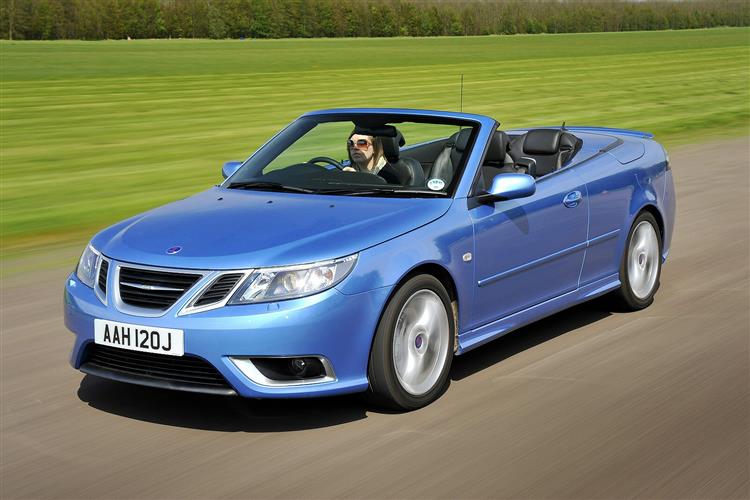SWEDE AS A NUT (some text hidden) --NONE--
BY ANDY ENRIGHT
Introductionword count: 90
When it comes to four seat convertibles, Saab have long guarded a very profitable niche. The MK2 9-3 Convertible is undoubtedly their best drop top to date and demand is consequently very strong. Although few genuine used bargains can be found, if you do your homework, you'll soon be able to work out what to avoid and what to target. With a reputation for solidity and available at prices considerably lower than you'd pay for an equivalent BMW or Audi ragtop, the Saab 9-3 Convertible continues to shift serious numbers.
Modelsword count: 20
Models Covered: (2dr convertible 1.8t, 2.0t, 2.0T, 2.8TV6, 1.9TiD, 1.9TTiD, petrol [Airflow, Linear, Linear, Linear SE, Vector, Vector Sport, Aero])
Historyword count: 216
Saab have had a representation in this market niche right back to the days of the 900 Convertible and the announcement of the Saab 9-3 Sport Saloon in 2002 marked a new direction. Whereas many previous Saab convertibles were modified versions of existing platforms, the drop top version of the 9-3 Sport Saloon was engineered in a more thorough manner to combat the torsional rigidity problems that had serious drivers avoiding the car. Three turbocharged petrol engines were available at the 2003 launch, starting with a 150bhp 1.8t powerplant, moving through to the 175bhp 2.0t and the range topping 210bhp 2.0T engine found in the Aero variants. In the early part of 2006, a 150bhp TiD diesel engine came on the scene with a 44.8mpg average fuel economy. In mid 2007, further alterations were announced to the exterior styling and the engine range. The 180bhp TTiD diesel arrived with its two stage turbocharger and the 2.8T V6 engine was upgraded to 280bhp. More interestingly, the XWD 4x4 system also arrived and the 2.0t BioPower engine was introduced to capture the environmental zeitgeist with its capability to run on E85 bioethanol. All models got a restyled front-end with a clamshell bonnet, a revised grille and LED light strips that sit across the top of the headlamp pod.
What You Getword count: 458
The Saab's hood may not be of the trendy folding hard top variety, but for a ragtop it's very impressive. Electrically operated, it requires no unlatching or arcane procedures to operate, and retracts in just 20 seconds, making it possible to drop the top at traffic lights without the potential embarrassment of being caught at half mast when the lights turn green. The hood's operation is very slick indeed. Instead of flipping up, an aluminium tonneau cover raises itself and then slides back, making for a quicker operation and a better seal than a traditional hinged cover. Saab's CargoSET system is another innovation of which the Swedes seem proud. This 'self expanding trunk' frees up a useful amount of luggage space in the boot - the kind of space that convertible owners in this class must usually forgo. The hood itself is triple skinned for improved noise and thermal insulation and is available in black or blue. In order to counter the dinginess that most convertibles suffer from when the hood's up, the Saab's hood is internally trimmed in either beige or light grey. The attention to detail is laudable. A small gutter has been sewn into the side of the fabric to prevent water droplets dripping onto the seats and there's also what Saab calls a 'surround trim'. This is basically a horseshoe-shaped line that runs from the base of each door pillar and incorporates the panels on top of the doors, the rear side trims and most of the tonneau cover. It's finished in a crackle matt black paint but can also be specified in body colour. It's a neat design idea that works particularly well with brighter colours. Aside from the flagship Aero model, two trim levels - Linear and Vector - are offered, the main difference for plusher Vector models being leather trim and the use of 17-inch alloy wheels. Front and side airbags, active head restraints, central locking, 16" alloys and a remote control alarm with immobiliser are standard fare, even if you go with Linear trim. The Aero features spoilers, sill extensions and more aggressive alloy wheels. Those of you who relish a spirited drive will appreciate the fact that the current car's chassis is three times more torsionally rigid than the rather noodle-like old 9-3. Saab developed a system they refer to as ReAxs, which passively steers the rear wheels to cut out the turgid understeer many powerful front wheel drive cars suffer from. Other novelties include DynaCage; Saab-speak for two spring-loaded rollover hoops that are recessed behind the rear head restraints which automatically deploy if the car thinks its falling over. Perhaps the most intriguing development is CargoWing, a rear spoiler that can convert into a ski or snowboard holder!
To see the full road test text contact us on 0330 0020 227
Pictures (high res disabled)

.jpg)
|
.jpg)
|
.jpg)
| |||
.jpg)
|
.jpg)
|
.jpg)
|
Statistics (subset of data only)
Min |
Max |
|
Insurance group 1-50: |
27 |
34 |
CO2 (g/km): |
137 |
199 |
Max Speed (mph): |
127 |
146 |
0-62 mph (s): |
7.1 |
10.7 |
Urban Mpg: |
22.4 |
44.1 |
Extra Urban Mpg: |
45.6 |
62.8 |
Combined Mpg: |
32.8 |
54.3 |
Length (mm): |
4668 |
|
Width (mm): |
1762 |
|
... and 4 other stats available | ||
Scoring (subset of scores)
Category: Convertibles
| Performance | |
| Handling | |
| Comfort | |
| Space | |
| Styling, Build, Value, Equipment, Depreciation, Handling, Insurance and Total scores are available with our full data feed. | |



